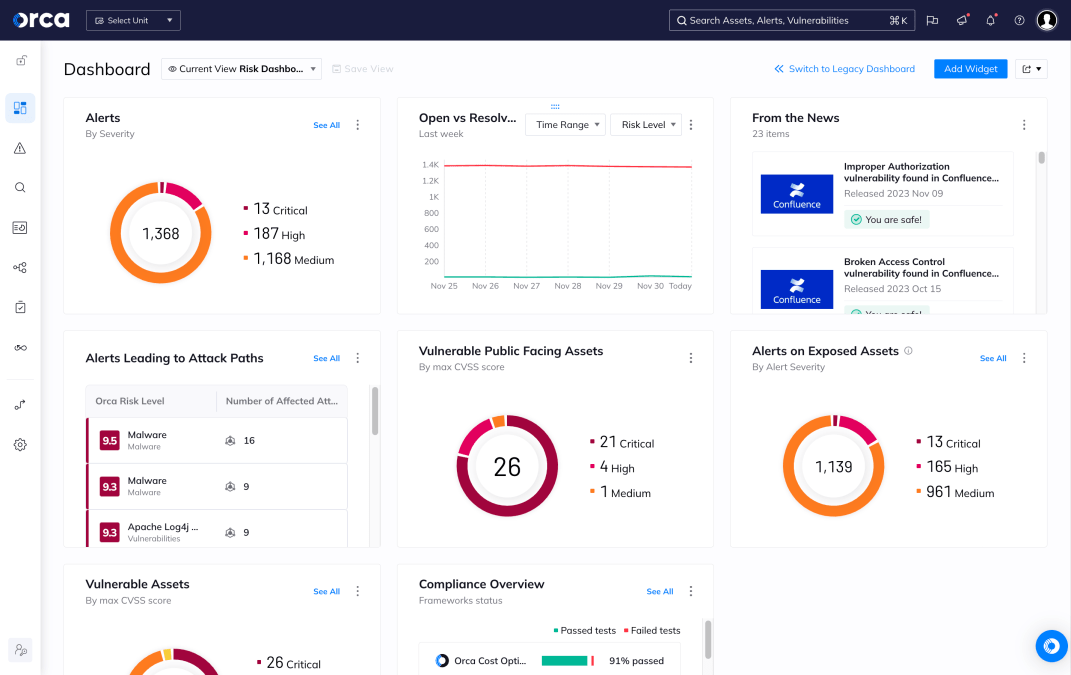A security vulnerability is a weakness or flaw in a system, application, network, or process that can be exploited by threat actors to gain unauthorized access, cause damage, or compromise data integrity. In cloud environments, security vulnerabilities span infrastructure components, containerized applications, serverless functions, and cloud service configurations, creating potential entry points for cyberattacks and data breaches.
Security vulnerabilities are among the most critical challenges in modern cybersecurity because they form the basis of most successful cloud attacks. The National Institute of Standards and Technology (NIST) maintains the National Vulnerability Database (NVD), which catalogs thousands of known vulnerabilities along with severity ratings using the Common Vulnerability Scoring System (CVSS).
Why is it important?
Security vulnerabilities pose significant risks to organizations operating in cloud environments where the attack surface extends across multiple layers. When left unaddressed, vulnerabilities can lead to:
- Data breaches
- Compliance violations
- Operational disruption
- Financial and reputational loss
Cloud adoption has intensified the importance of vulnerability management due to increased complexity, faster deployment cycles, and widespread use of third-party services. Orca’s 2025 State of Cloud Security Report found that the average cloud asset contains 115 vulnerabilities. Meanwhile, a separate analysis by VulnCheck revealed that vulnerability exploitation has also increased.
Vulnerabilities in a single container image can propagate across environments, while cloud misconfigurations—such as exposed storage buckets or over-permissive IAM roles—can compromise entire infrastructure segments. As a result, proactive vulnerability detection and response are essential to maintaining a secure cloud posture.
How does it work?
Security vulnerabilities in cloud environments arise from various sources:
- Software flaws: Bugs or insecure code in applications and libraries can enable attacks like injection, buffer overflow, or privilege escalation.
- Configuration errors: Insecure defaults or misconfigured access controls (e.g., open S3 buckets) are a leading source of cloud vulnerabilities.
- Outdated components: Unpatched operating systems, base images, and dependencies introduce known security flaws.
- Third-party risks: Vulnerabilities can be introduced via software supply chains or unmanaged external services.
The vulnerability lifecycle involves:
- Discovery: Found through automated scans, research, or incident forensics.
- Disclosure: Reported to vendors, researchers, or published in databases like the NVD.
- Assessment: Scored using CVSS based on severity and exploitability.
- Remediation: Fixed through patches, configuration updates, or code changes.
Cloud vulnerabilities can exist across multiple layers—compute, storage, APIs, identity, and networking—which require holistic assessment and remediation strategies.
Security risks and challenges
Cloud vulnerabilities present several unique and compounded risks:
- Lateral movement: Exploiting a single vulnerability may allow attackers to pivot across services.
- Zero-day attacks: Exploits may be available before patches are released or applied.
- Container risks: Vulnerable base images or dependencies in containerized environments.
- Serverless complexity: Functions with inadequate isolation or insecure logic are harder to monitor.
- Supply chain attacks: Malicious code introduced via third-party software or CI/CD toolchains.
CISA routinely publishes alerts about actively exploited vulnerabilities. As the threat landscape evolves, attackers increasingly exploit vulnerabilities in APIs, cloud services, and workload orchestration platforms.
The shared responsibility model further complicates matters—cloud providers secure the infrastructure, while customers must secure their usage, configurations, and applications. Many breaches result not from new vulnerabilities, but from poor visibility or unpatched known issues.
Best practices and mitigation strategies
Managing cloud vulnerabilities requires continuous, automated, and risk-informed practices:
- Automate scanning: Continuously scan infrastructure, applications, and container images across build and runtime.
- Prioritize based on risk: Focus remediation on vulnerabilities that affect sensitive data, are externally exposed, or are being actively exploited.
- Patch consistently: Apply updates to OS, libraries, and cloud services promptly.
- Secure configurations: Use policy-as-code and security baselines to prevent misconfigurations.
- Implement IaC scanning: Validate infrastructure templates (e.g., Terraform) for risky settings before deployment.
- Use runtime protection: Monitor workloads for anomalous behavior and known exploit patterns.
- Conduct regular assessments: Include vulnerability reviews in CI/CD pipelines and through red team or penetration testing.
Frameworks such as the OWASP Top 10 and CIS Benchmarks provide critical guidance for identifying and mitigating common vulnerabilities in cloud-based applications.
How Orca Security helps
The Orca Cloud Security Platform continuously scans cloud environments—including AWS, Azure, Google Cloud, Oracle Cloud, Alibaba Cloud, and Kubernetes—for vulnerabilities across runtime and development environments.
With Orca, organizations can:
- Detect and prioritize vulnerabilities with comprehensive intelligence that leverages more than 20 vulnerability data sources
- Perform Reachability Analysis to prioritize vulnerable packages that attackers can actually exploit in runtime
- Harness AI-driven capabilities to remediate vulnerabilities fast and easily—and from Cloud-to-Dev
- Leverage two-way integrations with developer workflows and tooling to accelerate remediation
By providing full multi-cloud coverage and dynamic risk prioritization, Orca enables security teams to enhance their vulnerability management programs and reduce the likelihood of exploitation.



